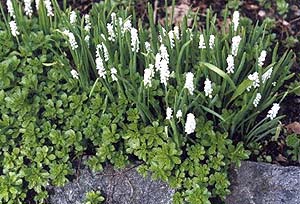RENEGADE GARDENER™
The lone voice of horticultural reason
Muscari
(Muss-CAR-ee)
Common Name: Grape Hyacinths
 I do so love it when the Muscari blooms in my garden. A couple hundred started two, three weeks ago, and are in full force right now, on May 12.
I do so love it when the Muscari blooms in my garden. A couple hundred started two, three weeks ago, and are in full force right now, on May 12.
It’s important to break the tulip-and-daffodil, tulip-and-daffodil mantra that impacts so many newer gardeners. Daffodils have their moments, but tulips can be a pain in the ass. Meanwhile, there are numerous other spring blooming bulbs to incorporate into the garden; Muscari is one of my favorites.
There are around 30 different species, but only four or five commonly available in the trade. The nice thing about them is, like most bulbs, you get good results ordering from mail-order catalogs. Regardless of how or where you buy them, they are truly a “plant and forget” flowering bulb, laughing off the coldest winters, then coming back stronger year after year.
M. armeniacum is the most common, the blue variety that most know, but pictured in my garden (mixed in with a Sedum) is the one I prefer, M. botryoides ‘album’. It’s nearly pure white, and at the front of the border (or sweeping away from view in swaths) it’s arresting. An added benefit is the sweet fragrance found with most (not all) species.
And in the north they are virtually impossible to kill. I think I planted these bulbs about ten years ago. I often forget exactly where they are, since they are everywhere. Later in the season, when their leaves have all but disappeared, I don’t worry when I dig, or move stuff, or plant something in or on them. No matter how much abuse, they are always cheerfully in bloom, right on time, next spring.
Care and Use
Bulbs are very small, plant them about 3″ deep at the front or near the front of the bed. They do well in semi-shady spots, or any place that has sun in early spring, before tree foliage takes it away. The only soil requirement is that the soil drain moderately well. I never fertilize them, just grow them in good garden soil that has been amended with organic matter.
All species hardy to Zone 3, M. latifolium reliably hardy to Zone 2.
Don Engebretson
The Renegade Gardener